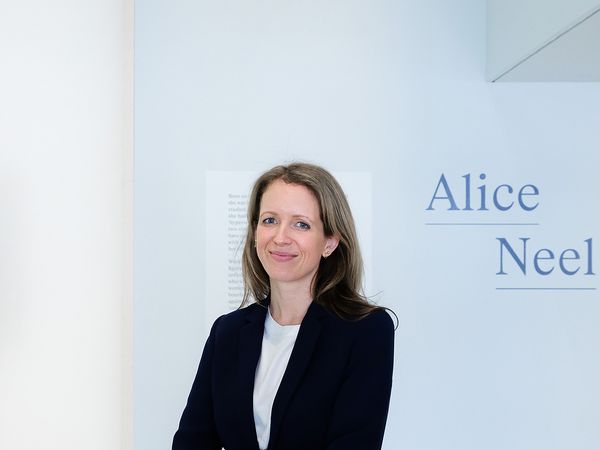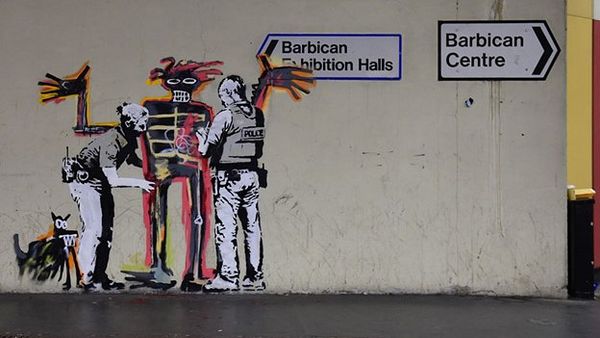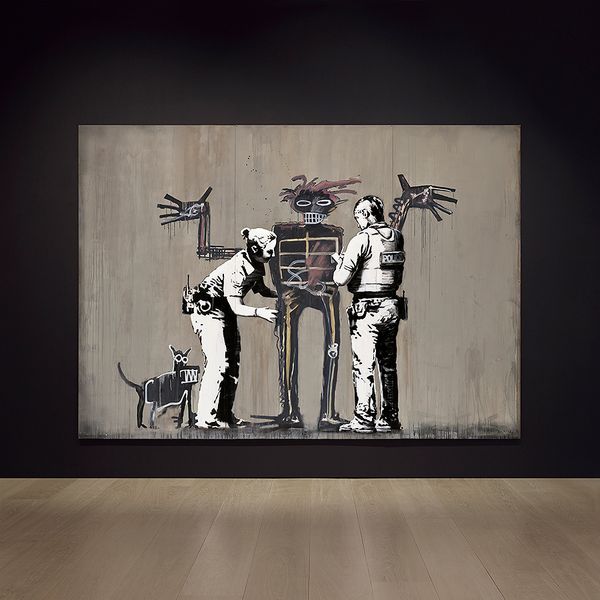Banksy, Banksquiat. Boy and Dog in Stop and Search, 2018. 20th Century & Contemporary Art Evening Sale.

Eleanor Nairne. Photo: Eva Herzog.
About the Writer: Eleanor Nairne is a curator based at the Barbican Art Gallery, where her exhibitions include Imran Qureshi: Where the Shadows are so Deep (2016), Basquiat: Boom for Real (2017-18), Lee Krasner: Living Colour (2019-20), Jean Dubuffet: Brutal Beauty (2021), Soheila Sokhanvari: Rebel Rebel (2022), and Alice Neel: Hot Off The Griddle (2023). She was previously Curator of the Artangel Collection at Tate, organising more than 30 exhibitions and displays across the UK. A regular catalogue contributor for international institutions and publications, she is also a Trustee for Heart Club, an organisation devoted to neurodivergent artists.
To apprehend is to grasp, in mind or body. At its root is the seizing of something, prehendere. Since the 16th century, the word has suggested the intervention of the authorities, and around the same time came a sense of anticipation, a feeling of menace on the horizon.
In the early hours of 17th September 2017, Banksy delved into this murky etymology with the creation of two murals devoted to Jean-Michel Basquiat and the exhibition I co-curated of his work at the Barbican, Boom for Real, which was set to open to the public four days later. Positioned in the concrete bowels of the Barbican Estate, where Golden Lane meets the Beech Street tunnel, this ‘unofficial collaboration’ coaxed onlookers to consider the complex politics at play in the alliterative collision between the Barbican, Basquiat and Banksy.
There had been no forewarning and at first, I thought it had to be a hoax; but here, pointed my friend, was the message on the official Instagram account, and there, he kindly gestured, was the work before us. I felt the bite of critique grinding against the institution and the power structures surrounding it, but also against me as Basquiat’s curatorial custodian – a sensation only sharpened by the element of surprise and the artist’s anonymity – tinged with admiration for the clarity of the image and its capacity to provoke debate.
The central figure was taken, seized you could say, from Basquiat’s 1982 painting Boy and Dog in a Johnnypump, which did not travel to London in 2017, although it was a highlight of the 1996 exhibition at the Serpentine. In Banksy’s rendition, the rich painterly background of pinks and peppermint green has evaporated, so that the skeletal figure and his dog take on a graphic starkness, with an alarming nimbus of red and orange like a memory of their former life. The work reflects on the formidable power of displacement to reshape a sense of self.
I feel most colored when thrown against a sharp white background.
—Zora Neale Hurston
In Basquiat’s original, paint is sprayed and dribbled across the canvas, giving an impression of the joyful release of a sweltering summer day when a Johnnypump (the New York nickname for a fire hydrant, in honour of its nineteenth-century inventor John Giraud) would be illegally opened so neighbourhood children could ‘swim’. Basquiat’s figure may be static, his arms held aloft and oversized fingers splayed, but the edge of his grin has been lifted to give an unmistakable touch of mischief. In Banksy’s mural, the grimace has become as rigid as the grill of an American football helmet, and no wonder, as he is flanked by two officers: a woman with radio and handcuffs on her hip leans down to frisk his right leg, while a man with ‘police’ on the back of his vest jots down notes. The dog looks on in horror.
At its most immediate level, Banksy’s work questions what kind of reception Basquiat, or any of the young Black figures he heroized, might have received in 21st-century London, a city that has long abused ‘stop and search’ powers. When the murals were made, Black citizens in the UK were six times more likely to be targeted, and Theresa May as Home Secretary had argued against the police tactic, given that as many as 250,000 searches a year were thought to be illegal. The monosyllabic phrase ‘stop and search’ violently underplays the assault of being apprehended in this way, not to mention the very real threat to life, both literally and in terms of personal sovereignty.
They say you appeared out of nowhere. Like magic … They don’t hear you. They don’t see you. They see someone, but that person is not you… You are hollowed out, like it was not just your bag they emptied.
—Caleb Azumah Nelson
This question of seeing and being seen is at the heart of Banksy’s critique. The Barbican is implicated not just in terms of timing and geography, but also in the careful siting of the mural next to a sign pointing towards the ‘Barbican Exhibition Halls’. In the 1970s, the Barbican marketed itself as a Centre for Conferences, Meetings and Exhibitions, which typically meant trade exhibitions of goods or services designed to raise revenue to support the activities of the arts centre; these spaces are no longer in use but the need to drive income is no less urgent. The sign draws attention to how commercial imperatives can easily cloud the vision of any cultural institution – when I pitched to stage a Basquiat exhibition in 2014, was he frisked for his artistic significance or his capacity for box office success?
Basquiat had already turned his figure inside out, parading his skeleton, so ideas of exposure and extraction are written into rather than onto the work. By 1982, he was an artist facing the dizzying reality of exhibitions in LA, Rome and Zurich, alongside the all too frequent struggle to hail a yellow taxi. Banksy amplifies the vulnerability coursing through that life and work and the bruising reality of how easily his spirit could be crushed in the hands of the institutions and individuals receiving and misperceiving it years down the line.
For Banksy’s statement to remain, it had to be protected by Plexiglas, only adding to the irony of the work given that most graffiti would be considered to be vandalising the grade-II listed Brutalist architecture and immediately washed away. At least it means it can be enjoyed in perpetuity and for free. And what is it that visitors come to encounter?
Banksy apprehends something of Basquiat’s complex negotiation of the art world – how he was constantly being interrogated by cultural authorities of one stripe or another, wanting to establish his promise, his place. Yet he found ways to make work that continues to wrest free from their grasp, let alone Banksy’s, or our own. Even within the iconography of the mural, the imitation of Basquiat’s painterly figure carries the life-charge of the image against the monochromatic stencilled police. And it is in part this irreducible brilliance that keeps visitors coming in search of his afterimage in the Beech Street Tunnel.

Banksy’s Barbican intervention, 2017.
Discover More from 20th Century & Contemporary Art >
Recommended Reading
